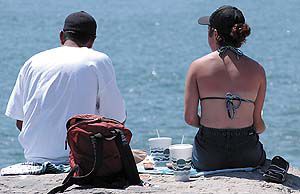| One camper sits with skin exposed while the other is covered up to protect his skin from the sun. There are many factors in sunburn including intensity, location and exposure time to the sun. Young people can increase their chances of melonoma later in life with just one bad sunburn. |
As millions of children and teenagers head off today to sleep away camp for the summer parents need to be thinking about the threat of skin cancer. In light of the current skin cancer epidemic, parents should be sure their child’s camp is sun safe. Just one blistering sunburn in childhood more than doubles a person’s chances of developing melanoma later in life.
Sports and outdoor activities are daily events for children attending camp. If children are not properly protected, the time they spend outdoors lead to painful sunburns, premature aging and skin cancer.
“Just one blistering sunburn in childhood can double the risk of getting melanoma later in life,” said Perry Robins, MD, President of the Skin Cancer Foundation. “That risk can be avoided by following some simple sun safety guidelines.”
Here are five essential sun safety questions every parent should ask before sending their child to camp.
•Are counselors trained in sun safety? UV protection should be a regular part of the training counselors receive. They should be well versed about the dangers of the sun and how to protect against them.
•When are outdoor activities scheduled? Ideally, most should be scheduled for early morning or late afternoon since UV is most intense from 10 a.m. to 4 p.m.
•Does the camp have adequate shade structures? While large shade trees provide some protection, a truly sun-safe camp should have structures such as pavilions where campers can seek shade during outdoor activities.
•Are campers directed to apply sunscreen before going outside? An SPF 15+ sunscreen (water-resistant formulas are especially good) needs to be used regularly. Campers and staff should be instructed to bring it from home, apply it 30 minutes before outdoor activities, and reapply every 2 hours and right after swimming or sweating.
•Are campers urged to wear protective clothing? Historically, campers wore only a T-shirt, shorts, and perhaps a baseball cap. We now know that’s not enough. Children should wear sun-protective clothing including long pants (or at least shorts), long-sleeved shirts, UV-protective sunglasses and a wide-brimmed hat to protect their face, neck and ears.
With proper guidance, children can learn to protect themselves and enjoy summer fun without sacrificing the health of their skin.
For additional information, visit www.skincancer.org or call 1-800-SKIN-490.

